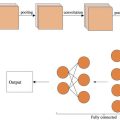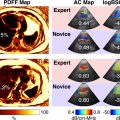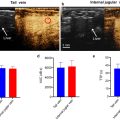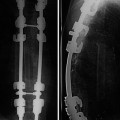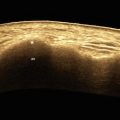Abstract
Objective
We assessed the diagnostic performance of ultrasound two-dimensional shear wave elastography (US 2D-SWE) to predict clinically significant fibrosis (CSF) in patients with serologic iron overload (SIO) and the subgroup with histologic liver iron overload (LIO).
Methods
A single-center retrospective cross-sectional study of adults with SIO (serum ferritin ≥ 200 ng/mL in females and ≥ 300 ng/mL in males) and suspected chronic liver disease with nonfocal liver biopsy results and US 2D-SWE exams within 1 year was performed. Histopathological fibrosis stage ≥2 and liver iron ≥2+ was considered CSF and LIO, respectively. Univariate logistic regression to assess prediction of CSF by Young’s modulus (YM) and serum ferritin was performed. Sensitivity and specificity were reported at optimal YM threshold determined by the Youden Index.
Results
272 cases were included (211 (77.6%) females, 88 (32.4%) CSF cases) with mean (± standard deviation) age of 50.0 (13.6) years. Median YM predicted CSF in patients with SIO (AUC 0.73, 95% confidence intervals (CI) 0.66 −0.80, odds ratio (OR) 1.12), p < 0.001. Optimal YM threshold was 11 kPa (sensitivity 58%, specificity 79%). Subgroup analysis of 47 LIO cases (39 women, mean age 52.5 ± 11.6 years, 17 (36.2%) CSF) showed that median YM predicted CSF (AUC 0.85, 95% CI 0.73–0.97, OR 1.39), p < 0.001. Optimal YM threshold was 11 kPa (sensitivity 77%, specificity 87%).
Conclusion
2D-SWE is a promising, widely available, and noninvasive tool for diagnosing liver fibrosis in iron overload, including when magnetic resonance elastography may be nondiagnostic due to iron-related artifact.
Introduction
Systemic iron overload is a diseased state that results from abnormal iron metabolism or excess iron intake. Hemochromatosis, a form of primary iron overload, is an autosomal recessive disease affecting 1 out of 300 of non-Hispanic White people in the United States [ ]. It is caused by a mutation in the HFE gene which leads to decreased hepcidin production, impaired iron transport, and excessive hepatic iron deposition [ ]. Secondary causes of iron overload, though less common than hereditary hemochromatosis, include excess parenteral or dietary iron consumption, chronic liver disease, frequent blood transfusion, or hemolysis [ ]. Excess liver iron predisposes to hepatic fibrosis which is characterized by excess collagen deposition and hepatic parenchymal architectural changes [ ] as a response to cellular injury. While fibrosis deposition may be self-limited, in a subset of patients (about 9% of men with hereditary hemochromatosis) [ ], it progresses to cirrhosis, a form of irreversible liver damage. Cirrhosis leads to liver failure, portal hypertension, and hepatocellular carcinoma which cause substantial morbidity, mortality, and healthcare cost. There is a critical need for accessible, safe, and accurate tools to facilitate early diagnosis of liver fibrosis to enable early therapeutic intervention to mitigate these sequelae.
Liver fibrosis has historically been assessed by nonfocal liver biopsy, which is the gold standard in diagnosis and staging. However, this invasive procedure is costly, painful, suffers from sampling error, and may cause serious bleeding or, in rare cases, death [ ]. Alternative noninvasive imaging biomarkers to detect and stage liver fibrosis have emerged in recent years. Magnetic resonance elastography (MRE) is a promising noninvasive technique which quantifies liver stiffness, a surrogate marker of liver fibrosis. It has been extensively explored for the study of liver fibrosis in the setting of viral hepatitis and nonalcoholic fatty liver disease (NAFLD), with demonstrably high accuracy [ ]. MRE has also been explored for the purpose of staging liver fibrosis in cases of iron overload [ , ] with the particular advantage that multiecho Dixon techniques can simultaneously quantify liver iron deposition [ , ]. However, MRE is a gradient echo technique prone to susceptibility artifact from excessive iron deposition which degrades signal intensity; it may lead to technical failures [ ] and nondiagnostic readings [ ]. 55%–70% of all MRE technical failures are due to liver iron. In general, magnetic resonance imaging (MRI) also suffers from high cost, limited availability, and inability to image patients with contraindicated implanted devices and claustrophobia [ ].
Two-dimensional shear wave elastography (2D-SWE) is a similar established noninvasive ultrasound-based technique to quantify liver stiffness as a marker of fibrosis. Modern ultrasound scanners use focused ultrasound to generate shear waves and high temporal resolution B-mode imaging to track and quantify shear wave velocity. This technique is widely available, safe, low cost, painless, and demonstrates good accuracy across NAFLD, viral hepatis, and other conditions with AUCs ranging between 0.88 to 0.91 [ ], 0.97 to 0.98 [ ], and 0.86 to 0.93 [ ], respectively for significant and advanced fibrosis. 2D-SWE is not affected by liver iron deposition, unlike MRI, which poses a unique opportunity for 2D-SWE to assist in the evaluation and staging of liver fibrosis in cases of iron overload. However, there are limited reports of 2D-SWE in patients with iron overload and validated thresholds for liver fibrosis staging in iron overload do not currently exist.
We aim to fill this knowledge gap by assessing the diagnostic performance of 2D-SWE to predict clinically significant fibrosis (CSF) in patients with serologic iron overload (SIO) and the subgroup with histologic liver iron overload (LIO). Our primary objectives are to determine if 2D-SWE is a significant predictor of CSF (≥F2) in patients with iron overload (SIO and LIO) and to quantify its sensitivity and specificity, with histopathology obtained through liver biopsy as the reference standard. In a similar manner, we also aim to determine its performance in predicting advanced fibrosis (≥F3). Additionally, we wish to explore if serological indicators of iron overload predict fibrosis. If validated, 2D-SWE may serve as an alternative to liver biopsy and nondiagnostic MRE for early diagnosis, staging, and longitudinal monitoring of hepatic fibrosis in this population.
Materials and methods
This Health Insurance Portability and Accountability Act compliant single-center retrospective cross-sectional study conformed to the ethical guidelines of the 1975 Declaration of Helsinki and was approved by the local institutional review board, which waived the requirement for obtaining informed consent.
Adults with SIO and suspected chronic liver disease (CLD) with nonfocal liver biopsy results and US 2D-SWE exams in the last decade (2012–2022), were identified utilizing an institutional electronic medical record search tool. SIO was diagnosed at serum ferritin levels ≥ 200 ng/mL in females and ≥ 300 ng/mL in males. Patients with 2D-SWE exams that occurred beyond 1 year of liver biopsy or with a history of previous liver transplantation, active malignancy, or having received chemotherapy in 1 year prior to liver biopsy or 2D-SWE, were excluded.
Demographic data (age, sex, racial and ethnicity data, BMI, alcohol, and tobacco use) along with clinical diagnosis (diabetes mellitus, hypertension, diagnosis of liver disease: i.e., NAFLD, viral hepatitis, alcoholic liver disease, autoimmune hepatitis (AIH)) and laboratory tests (hematological iron markers- serum ferritin, iron, hematocrit, total iron binding capacity (TIBC), transferrin and saturation) were extracted. Test interval (days between 2D-SWE and serum ferritin test) was calculated.
Standard-of-care liver biopsy specimens were reviewed by a board-certified clinical pathologist and fibrosis stages were extracted from clinical pathology reports. Various clinical histologic staging systems were used during patient care including NASH-CRN (82/272, 30.15%), Brunt (97/272, 35.66%), Ishak (34/272, 12.50%) and METAVIR (2/272, 0.74%). Ishak ≥ 3 was CSF and ≥4 was advanced fibrosis. For all other staging systems, fibrosis ≥2 was significant and ≥3 was advanced. Visual grading (Scheuer grades 0–4+) of liver iron (through iron staining on histopathological examination of biopsy specimen) was performed by a board-certified clinical pathologist and grade ≥2+ was considered liver iron overload (LIO) [ ].
We reviewed 2D-SWE ultrasound exams performed on Aixplorer (SuperSonic, Aix-en-Provence, France) (252/272, 92.65%) and LOGIQ E10 (11/272, 4.04%) or E9 (9/272, 3.31%) devices (General Electric Healthcare, Wauwatosa, WI, USA), and extracted liver stiffness measurements from the medical records. All patients were asked to fast for at least 8 hours prior to their 2D-SWE exam. 2D-SWE exams were performed by clinical sonographers during routine patient care. Patient laid in either a supine position or with a slight left tilt, with their right hand placed above their head throughout the procedure, as per institutional acquisition protocol. The transducer was placed intercostal in the right upper quadrant, with a perpendicular alignment to the liver capsule. The elastography box was aligned parallel to the liver capsule and region of interest (ROI) measurements were obtained at least 1.5–2.0 cm from the liver capsule to prevent reverberation artifacts. A sequence of 7 to 12 (target of 10) measurements were acquired per exam. Values reported in meters per second (m/s) were converted to kilopascals (kPa). Median Young’s modulus (YM) (in kPa) was calculated for each subject and was the unit of analysis. A median YM <50 kPa from at least three 2D-SWE measurements constituted a valid case. Clinicopathological interpretation was done using conventional cut-offs (i.e., CSF >7 kPa and advanced fibrosis > 13 kPa) [ , ]. Interquartile range (IQR) was calculated through the quartile method using Microsoft Excel “quartile.inc” function for the third and first quartiles. An interquartile range to median (IQR/M) ratio ≥ 30% indicated an unreliable 2D-SWE exam with nondiagnostic liver stiffness measurements.
MRI of the upper abdomen, including MRE, was performed on a 1.5 Tesla (T) (1/12, 8.33%) or 3T (11/12, 91.67%) whole-body MR scanner with an eight-channel torso (upper body) phased-array coil. Images from SignaHDxt (2/12, 16.67%), Signa Premier (8/12, 66.67%), and Discovery MR750 (2/12, 16.67%) (GE Healthcare, Milwaukee, WI, USA) were reviewed. Patients were placed feet—first in the supine position and instructed to hold their breath at the end of expiration during slice acquisition. Hepatic fat fractions and R2* (reported in values per second) were acquired for the entire liver (using automated segmentation) and for a technologist-specified ROI using a clinical multiecho DIXON acquisition [ , ]. Liver iron concentration (LIC) was estimated from R2* (s -1 ) values at 1.5T and 3T in mg Iron (Fe)/g dry weight using the formulas [0.027R2* – 0.26] and [0.015R2* – 0.32], respectively; one exam used a different formula [0.032R2*] [ ]. A 19 cm-diameter, 1.5 cm-thick, cylindrical passive longitudinal driver with about 60Hz frequency (MR-Touch; GE Healthcare, Milwaukee, WI, USA) was fastened to the anterior torso at the level of the xiphisternum to obtain the MRE images. A two-dimensional, gradient-echo MRE sequence was employed. All MRE images were reviewed by a clinical abdominal imaging subspecialty trained board-certified radiologist [ ], and representative mean liver stiffness measurement (kPa) was reported per exam. All LIC and liver stiffness estimates were obtained from noncontrast images. Clinicopathological interpretation of mean liver stiffness was done using conventional cut-offs (i.e., Normal <2.5 kPa, 3.0 to 3.5 kPa = Stage 1–2 fibrosis, 3.5 to 4.0 kPa = Stage 2–3 fibrosis, 4.0 to 5.0 kPa = Stage 3–4 fibrosis, Stage 4 fibrosis or cirrhosis >5.0 kPa) [ ].
Data analysis was conducted using R Studio based on R language, version 2023.06.0 + 421 [ ]. Two authors (SH, TTP) performed the analyses. A p -value less than 0.05 was considered statistically significant. Descriptive statistics using continuous variables were calculated as mean ± standard deviation (SD) or median ± IQR based on variable normality and compared using a t-test or Wilcoxon rank sum test. Categorical variables were tabulated as counts (percentages) and compared with Fisher’s exact test. The primary endpoint was assessing median YM as a predictor of CSF in SIO and LIO groups using univariate logistic regression to estimate an odds ratio (OR) with a 95% confidence interval (CI). Discrimination was quantified by plotting receiver operating characteristic curves and calculating the area under the curve (AUC). Sensitivity and specificity were reported at the optimal threshold determined by the Youden Index. Subgroup analysis was performed after excluding patients elevated AST or ALT more than five times the upper limit of normal for the laboratory assay. Among SIO patients with liver iron histology results, logistic regression models were created to assess YM prediction of CSF before and after controlling for the grade of liver iron deposition. A similar analysis was performed for median YM as a predictor of advanced fibrosis in both subgroups. Additional analysis was performed to assess MRE mean liver stiffness (kPa) as a predictor of CSF and compared against 2D-SWE performance (compared AUCs by DeLong test), in this subgroup of patients with both 2D-SWE and MRE. Exploratory analyses were performed for serological indicators of iron overload (TIBC, serum iron, hematocrit, hemoglobin, and serum ferritin) as univariate predictors of clinically significant and advanced fibrosis. The association between LIO and YM was assessed by logistic regression.
Results
272 patients were identified (211 females, 77.6%) with mean (± standard deviation) age of 50.0 ± 13.6 years ( Table 1 ) . 88 (32.4%) cases had CSF and 47 (17.3%) had advanced fibrosis. Most participants underwent biopsies due to elevated liver function test values or transaminitis (100, 36.8%), iron overload/hemochromatosis (22, 8.1%), and NAFLD/nonalcoholic steatohepatitis (150, 55.1%). Biopsies were performed on the same day as the 2D-SWE in 252 (93%) cases, within 3 months in 265 (97%) cases, and within 6 months in 269 (99%) cases. There were 33.1% unreliable 2D-SWE measurements (90/272, 33.1%).
| No Fibrosis (F0, F1) [N = 184] | Significant fibrosis (F2-F4) [N = 88] | Total [N = 272] | p value | ||||
|---|---|---|---|---|---|---|---|
| Value | Missing | Value | Missing | Value | Missing | ||
| Age (years) | 48.9 (13.8) | 52.0 (12.8) | 49.9 (13.6) | 0.06 | |||
| Female | 144 (78.2%) | 67 (76.1%) | 211 (77.6%) | 0.76 | |||
| Race | 179 (97.3%) | 5 | 84 (95.5%) | 4 | 263 (96.7%) | 9 | 0.48 |
| White | 150 (81.5%) | 64 (72.7%) | 214 (78.7%) | ||||
| Black | 7 (3.8%) | 6 (6.8%) | 13 (4.8%) | ||||
| Asian | 10 (5.4%) | 5 (5.7%) | 15 (5.5%) | ||||
| Other | 12 (6.5%) | 9 (10.2%) | 21 (7.7%) | ||||
| Hispanic | 10 (5.4%) | 21 | 10 (11.4%) | 4 | 20 (7.4%) | 25 | 0.08 |
| BMI (kg/m 2 ) | 29.5 (6.6) | 15 | 29.9 (8.1) | 4 | 29.6 (7.2) | 19 | 0.65 |
| Diabetes | 35 (19.0%) | 2 | 30 (34.1%) | 0 | 65 (23.9%) | 2 | 0.009 |
| Hypertension | 70 (38.0%) | 2 | 51 (58.0%) | 0 | 121 (44.5%) | 2 | 0.003 |
| Hemochromatosis a | 13 (7.1%) | 9 (10.2%) | 22 (8.1%) | 0.48 | |||
| Viral hepatitis | 4 (2.2%) | 2 (2.3%) | 6 (2.2%) | 1.00 | |||
| Alcoholic liver disease | 4 (4.3%) | 8 (9.1%) | 12 (4.4%) | 0.02 | |||
| NAFLD | 98 (53.3%) | 48 (54.5%) | 146 (53.7%) | 0.90 | |||
| AIH | 7 (3.8%) | 2 (2.3%) | 9 (3.3%) | 0.72 | |||
| Hemoglobin | 14.1 (2.3) | 13.6 (2.2) | 13.9 (2.3) | 0.13 | |||
| Hematocrit | 41.7 (6.3) | 1 | 40.3 (6.2) | 41.2 (6.3) | 1 | 0.11 | |
| Ferritin | 453 [508] | 561.5 [531.5] | 496.5 [552] | 0.94 | |||
| Iron | 100.5 [56.5] | 30 | 101 [67.8] | 6 | 101 [59] | 36 | 0.75 |
| TIBC | 287 [73] | 38 | 292 [83] | 10 | 288.5 [77.8] | 48 | 0.80 |
| Transferrin | 35 [18.5] | 108 | 38.5 [33] | 44 | 36 [28.2] | 152 | 0.88 |
| AST | 50 [62] | 3 | 77 [68] | 1 | 59.5 [68.3] | 4 | 0.004 |
| ALT | 70 [97] | 3 | 78 [101.5] | 1 | 73 [98] | 4 | 0.78 |
| ALP | 86 [59] | 3 | 111 [84] | 1 | 92.5 [70.5] | 4 | 0.006 |
| Total Bilirubin | 0.6 [0.6] | 3 | 0.7 [0.6] | 1 | 0.7 [0.6] | 4 | 0.20 |
| Young’s modulus | 8.2 [3.9] | 12 [9.8] | 8.8 [5.4] | <0.001 | |||
| IQR/M | 17.2 [25.3] | 19.9 [28.5] | 18.5 [25.9] | 0.42 | |||
| Low-quality cases | 62 (33.7%) | 28 (31.8%) | 90 (33.09%) | 0.59 | |||
| Test interval b | 52.0 [122.2] | 53.5 [97.2] | 53.5 [113.5] | 0.56 | |||
| Scheuer Score | 151 (82.1%) | 33 | 76 (86.4%) | 12 | 227 (83.5%) | 45 | 0.12 |
| 0+ | 68 (45.0%) | 44 (57.9%) | 112 (49.3%) | ||||
| 1+ | 53 (35.1%) | 15 (19.7%) | 68 (30.0%) | ||||
| 2+ | 20 (13.2%) | 13 (17.1%) | 33 (14.5%) | ||||
| 3+ | 9 (6.0%) | 4 (5.3%) | 13 (5.7%) | ||||
| 4+ | 1 (0.7%) | 0 (0%) | 1 (0.4%) | ||||
Stay updated, free articles. Join our Telegram channel

Full access? Get Clinical Tree



